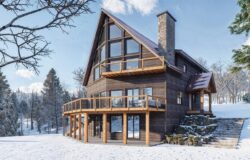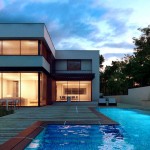Making of Private Residence
Phil Buerer is not stranger here, with two best of week awards (BOW 22/2014 and BOW 33/2014) and two articles published as well! Today I’m very happy to publish his third article about the making-of Villa Lanaras. He recreates an already built project, as he usually likes to do from photos. Just a single photo this time. This house was designed by architect Nicos Valsamakis at Anavyssos back in 1963. Cinema 4d, V-Ray for Cinema 4d and Photoshop are the main tools used in this project. Enjoy!
Introduction
Hello, and thanks Ronen for the opportunity to write about my Project “Private Residence” in this blog. It’s not the biggest project I ever did but definitely one of my favorite renderings. Its simplicity is what I find most appealing.
Whenever I can, I do personal projects, where I can explore new things, without outside pressure but a lot of opportunities to fail. And learn from said failures without taking hits in terms of customer satisfaction. Such as in this case.
A long time ago I came across a greek architect by the name of Nicos Valsamakis. He rose to fame in the ninety sixties with spectacular designs of villas. For years, I had this particular photograph from his “Villa Lanaras, Anavyssos” on my desktop. Always thinking that one day I’m gonna try to create a rendering from this shot.
Here’s the original photograph (source: midmodandmore.blogspot.ch).
Then after a while I finally did it, here’s the result.
3d Modeling
The modeling part was obviously very simple in this case. It’s easy to get the right height proportions from the photo with some guidelines. We could even calculate the right depth by using some simple math, or in my case guesswork : (https://de.wikipedia.org/wiki/Rekonstruktion_(Darstellende_Geometrie) – Article only available in German).
The starting point was an estimation of 150 cm height for the car.
The Model consists of cubes placed in the right place with assumed proportions. Some extruding and voila. Nothing magic here.
In order to check the modeling process and to match the camera position and focal length, I placed the original photo in the background of the semi-transparent model of the house. While sitting in the camera I moved and rotated manually until the preview more or less with the original photo.
Still using the picture as a reference I used a simple plane for the terrain. Subdivided just enough to be able to get the main contour lines. Then I just “painted” the terrain by subtly changing the Z value of the vertices with the “Magnet” tool (keeping X and Y locked).
Lighting
Opposed to elsewhere light comes after modeling. I knew I was going to use an HDRI in order to get a realistic rendering. While V-Ray Physical Sun and Sky render faster, I still prefer a high-quality HDRI for optimized results.
This is especially the case for exterior renderings. Here’s an interesting post about HDRI quality : http://www.aversis.be/tutorials/vray/vray-high-dynamic-range-hdri.htm.
I used Peter Guthrie’s 1224 Clear Sky in an Area/Dome light. By using a C4D “Filter” I lowered the gamma value to 0.7 in order to get sharper shadows.
Environment
Time for the most time-consuming part of the project. The environment and as part thereof the vegetation is where I invested the most time, getting the small details right. I wanted plants etc. to be as realistic as possible in order catch the eye and lock it on to details that don’t look too organized. Giving the whole scene a touch of organic chaos in contrast to the very structured look of the house itself.
I used 36 individual 3d models from my personal library (some Evermotion, Turbosquid, HQ-Plants and a few self-made models too).
Here’s a top-view of the plants, stones, branches etc, as placed in the scene.
Usually, I start by placing the largest plants first and filling in with objects decreasing in size. First, I duplicated the terrain plane and removed the polygons, where no plants would be placed. Using Cinema4D’s fabulous “MoGraph” object I distributed my models on the remaining polygons with the “Random Effector” linked into “MoGraph” in order to rotate and scale the objects automatically and randomly.
Starting with a few large ones, and filling it with more and smaller objects.
For the road, I used the same technique, from the larger stones and objects to small pebbles.
Here’s an image of the result.
The car model is from Archive 3D. Just had to create the V-Ray materials. If only it was that easy to get an Aston martin outside the virtual world… but still, thanks archive3d.net for the digital version. http://archive3d.net/?a=download&id=315d6747
Texturing
On the house, I generally used very simple and basic materials. Nothing too fancy here. The most complex material was for the terrain. It consists of 3 textures. One for the sand and one for the road blended together into one material with a “Vertex Map” and masked with Cinema4D layers. This is to achieve a smooth transition from sand to road, and will be explained in detail below. The third texture is car-tracks I painted in Photoshop and used for the bumps and shading on top of the first material. Then I used “Mix Textures” to blend the sand/stone and the tracks together. All in all less complicated than it sounds.
To blend the sand and the gravel on the road together, and achieve that smooth transition I mentioned above, I first painted a “Vertex Map” which I then used on a new material to separate the two main textures.
Now, I assigned a new “VrayAdvancedMaterial” to the terrain. Using Cinema4D layers, the “Vertex Map” can now be used as a mask in the diffuse channel, blending the road texture on top into the sand texture at the bottom.
In order to imprint the ruts on the gravel road, I created a new material on top of the terrain material. Enabling the mix textures option, and using the b/w ruts texture as the material weight, I was able to manage the car-tracks independently from the main material. For the car-tracks material I just varied the color and bump setting ever so slightly, to get a subtly different look for the gravel, where I wanted the car-tracks to show.
The result is barely visible in the end, but in my opinion, an important detail, giving the scene depth. Here’s the final terrain material.
The other very important materials are those for the vegetation. Some of the ready made plant models came with great 2sided materials which didn’t need any adjustments at all while others only had a color assigned. Or, something that every Cinema4d user probably came across, a load of obj, fbx models with no materials 🙁 I tried to use only 2sided materials. Frankly a must for leaf shaders. Also, for added realism, I made an extra effort to create a lot of variation in the green tones. Here’s one example.
Then combined with a 2 side material.
And here’s how this material looks like applied to a model.
Rendering
First of all, let’s take a look at the camera settings.
Here are the render settings for the final output with a resolution of 5888×3944 pixels.
The final rendering was saved as a 16 bit TIF, with z-depth, specular, reflection, and material ID’s rendered in separate passes.
Postwork
The rendering was significantly edited in Photoshop. I would say the real magic was added in post.
The raw render was over saturated, with little contrast and almost no depth. A perfect starting point for the post ;). Over the last years, I found myself always performing the same steps. So, here are my well rehearsed secret magic techniques. Because it’s secret I won’t go over every single layer, hah!
Folder “pass”, all render passes are placed and adjusted here.
Folder “kore”, where I do the main exposure, curves, brightness and contrast.
Folder “color”, most important one, main color correction is happening here.
Folder “effect”, the experimenting folder, FX.
Folder “filter”, color lookup and so on.
Folder “fin”, lens correction, sharpening and so on.
At this point, I was very happy with the result, but I decided to make another more dramatic version. With some filter re-combinations from the previous version, I ended with this version.
Fin
And that’s it. I really hope that some information, somehow, somewhere, helped someone. Feel free to ask anything in the comment section below.
Saludos, Phil

Phil Buerer is a freelance digital artist, with a great passion for architectural visualization. Educated and certified as a draftsman and web & media publisher he works with pencils, sketchbooks and construction drawings, as well as pixels & polygons.
















































Thanks again Ronen! It was an honour 🙂
Beautiful work and tutorial. I learned from you.
I would just increase the bump/displacement on the white wall to really feel its materiality. About lightning you only used the area light ? Thanks in advance
I love how you’ve used a film filter! always a fan of film photography
DannyKaiKaeShiuh Thanks. Me too 🙂
bernardotcs i’m glad you like it. And thanks for the hint.
It’s great to see someone produce top notch images in C4D.
Thanks Phil!
I didn’t know MoGraph could come in handy in distributing objects – looking forward to trying that myself!
Lukas79463 thank you. MoGraph is an amazing tool, I use it all the time.
very good render as a user of cinema 4d I would like to know if you have any advice on postproduction or whether you took a course, is an area that I very difficult and I can not give life to my renderings, you are a hope for me as a user who thought in switching to 3d max, excellent job, congratulations !!
SaulPerez1 Hi Saul! I know exactly what you mean. I was thinking to switch to max too some time ago. Not because I thought it’s the better software, simply because there’s much more from everything, models, tutorials, plugins, newest renderer… but, on the other side, cinema 4d almost never crash, it is veeeeery user friendly and it’s the one right after max (in archviz I think). At the end it’s just a tool and it really doesn’t matter for the quality of the renderings. And for post production, I always check for tutorials/making ofs.. (here soem good ones: https://www.youtube.com/watch?v=-eKAdAHgPE0&list=PLcmjY8ZjKzLDiSBp1EsC7N_kv0YPB–hY&index=15) but the most important one is practice practice practice…